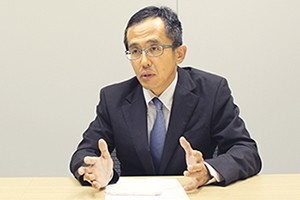Blog
Learn the secret of the safety punctuality and comfort of Japanese railways.
An Advanced Nation in Rail/ Understanding Japan's Common Sense
No.2: The Amazing Punctuality of Japanese Trains
Trains came into use as a solution to the problems of congestion and pollution caused by automobiles, the main means of transportation in the past.

Yosuke Nakazawa
Technology Executive of Railway Systems Division at Toshiba Corporation Infrastructure Systems & Solutions Company
Yosuke Nakazawa, Technology Executive of Railway Systems Division at Toshiba Corporation Infrastructure Systems & Solutions Company, reflected on this history with the following: "Cars were used for transportation in urban centers during the 1950s, a period of rapid economic growth in Japan, but this led to issues of congestion and pollution.
The establishment of train systems improved transportation convenience in city centers, thus helping to solve the issue of chronic traffic jams. I believe a similar transportation system shift, from cars to trains, will occur overseas as well."
This blog post will explain one of the factors which contributed to the high quality and punctuality of railway operations in Japan.
Train Timetables
A train timetable is an operation plan describing the train schedules and their arrival and departure times at each station. Timetables are generally designed to meet varying passenger demand in different times. For example, one train might come every 10 minutes during regular hours, but during the morning rush hour, one train might arrive every three minutes to avoid overcrowding. In addition, if there are special events, the timetable can be adjusted to handle an increase in passenger volume by operating more trains on those days. However, timetables that meet passenger demand alone does not necessarily result to good service quality and high punctuality. What is it that makes railway operations in Japan more punctual than other railway operators around the world?
Detailed Transit Scheduling Realizes On-time Operation
In Japan, trains are not simply added indiscriminately to meet demand. Rather, every factor that would affect operations, such as the exact time that trains stop at each station (dwell time) and the exact time that trains travel from one station to the next (running time), are carefully adjusted; conflicting scenarios are resolved; possible scheduling situations likely to impact punctual operations are investigated; historical train traffic data are factored in to identify points for improvement; and cooperative brainstorming with other railway companies are regularly held to ensure smooth operations in shared routes. The result of all these painstaking and meticulous work are robust, efficient and optimum timetables. These timetables then form the basis for controlling the operations of the railway system. This is one of the secrets behind Japan's famous punctuality - detailed transit scheduling.
Amazingly, all of these minute details and adjustments to the timetables work together to keep punctuality of train services in Japan. Trains come and go precisely as scheduled, and few trains are ever late. There are many train companies in Japan and the rail network is mind-boggingly complicated, yet they are all mostly consistent in terms of on-time operation. It is said that overseas visitors to Japan are always impressed by this great punctuality.
It is entirely possible for advanced rail transit to be achieved in other countries by introducing transit scheduling methods like those of Japan, a challenging environment of high-density transit.
The next blog post will discuss safety, another feature of transit scheduling.



